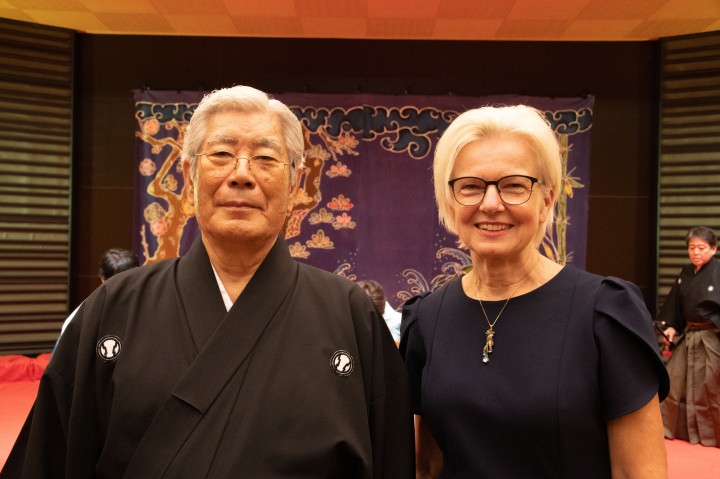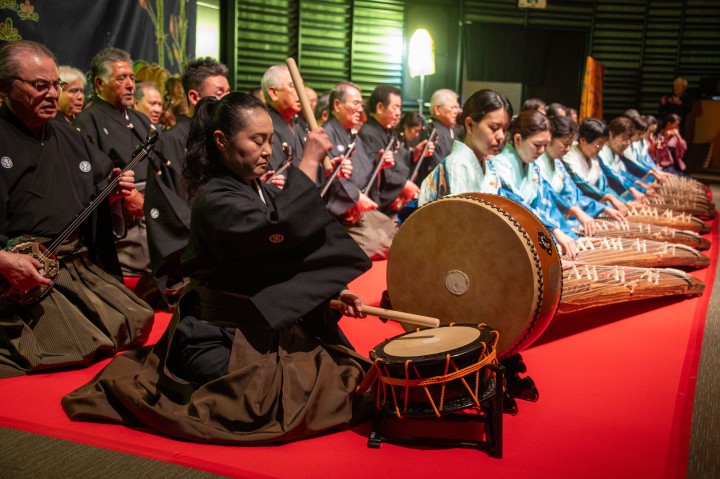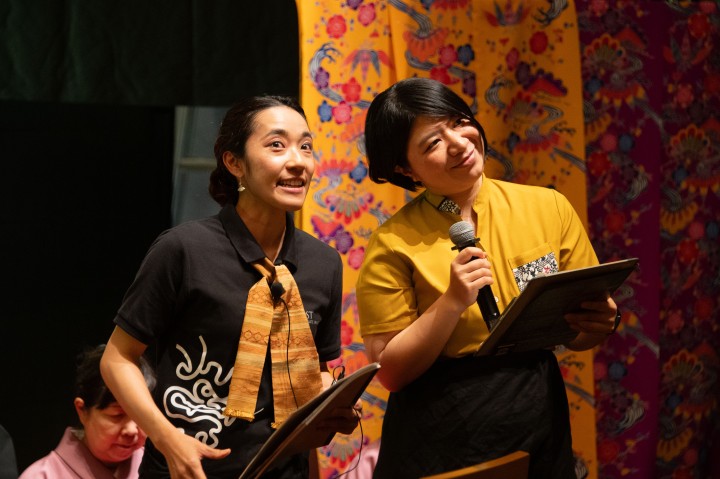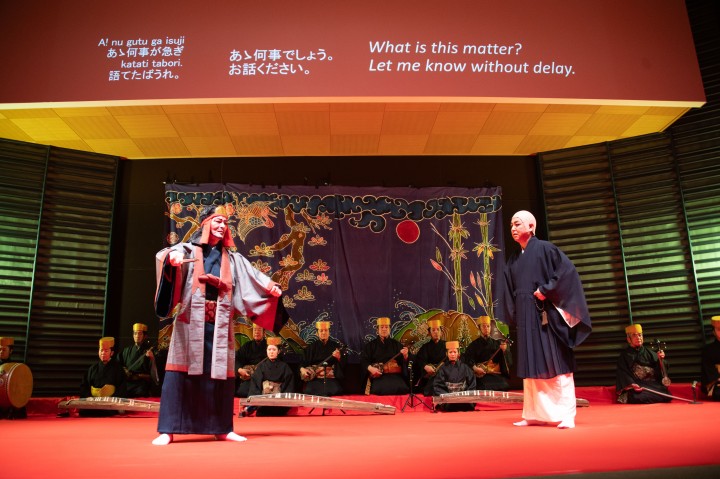"Sounds of the Ryukyus", which marks its 7th edition this year, was held on Sunday, March 17, at the Okinawa Institute of Science and Technology (OIST). The traditional Ryukyuan arts performance by the Traditional Music Association of the Nomura School of Ryukyuan Classical Music, was an annual event at OIST, but was canceled due to the COVID-19 pandemic. It was held for the first time in about four years, and the sound of beautiful Uta-sansin, koto, and drums echoed through the OIST Auditorium.
The Traditional Music Association of the Nomura School of Ryukyuan Classical Music is dedicated to the inheritance and development of traditional Okinawan culture and performing arts and celebrated its 40th anniversary in 2022. President Toshikazu Tamaki said, "OIST attracts staff and students from all over the world, and we want to provide an opportunity for people who do not normally have the chance to experience and enjoy traditional Ryukyuan culture. We are happy to be a bridge between the local and international communities through traditional performing arts." The event was a highly successful, attended by OIST faculty and staff as well as residents and tourists.


This year's performance featured ten programs, including performances of Ryukyuan classical music, Ryukyuan dance, and Kumi odori (combination dance consisting of lines, dance, and music).
Ryukyuan classical music is designated as an Intangible Cultural Property of Japan (Okinawa) and has been enjoyed by court nobles since the Ryukyu Dynasty. Today, it is performed not only within the prefecture but also by many people from other prefectures and even overseas. "Kumi odori" and "Ryukyuan dance" performed at Shuri Castle to entertain envoys from China are now recognized by the Japanese government as Important Intangible Cultural Properties. Furthermore, Kumi odori, which has a history of over 300 years, was registered as a UNESCO Intangible Cultural Heritage in 2010.

The programs were introduced by two OIST staff members, Misato Matsuda and Chiaki Chibana, in the Okinawan language "Uchinaguchi," English, and Japanese. They are both members of the "Eedee" group,dedicated to promoting Uchinaguchi and Okinawan culture at OIST. Eedee means "working together" in Uchinaguchi. The audience was diverse, includeding men and women of all ages, who felt at home from start to finish, often seen smiling as they listened to the proceedings in Uchinaguchi, a language cherished by Okinawans.

Children also showcased the traditional performing arts which have been passed down from generation to generation in a charming yet powerful way. The youngest performer this time was five years old, and the oldest 90. This diversity was reflected in the audience as well.

OIST has over 1,300 staff and students from both local and international backgrounds, many of whom are training in Ryukyuan dance and traditional performing arts to become familiar with Okinawan culture. On this occassion, two Okinawan staff members, Ami Chinen and Naoko Tokumoto, graced the stage with theirRyukyuan dance performance.
OIST Professor Nic Shannon and staff members Taku Arai, Tomomi Okubo, Marina Kyan, and Meria Miller made a special appearance. They played the sanshin, a traditional Okinawan instrument) for the opening act., This performance was a collaboration with members of the Traditional Music Association of the Nomura School of Ryukyuan Classical Music. Ms. Miller, a dedicated member of the Traditional Music Association of the Nomura School of Ryukyuan Classical Music, is honing her skills on the sanshin. Her goal is to become a jikata, a person responsible for musical accompaniment in Kumi odori and Ryukyuan dance. During the intermission, she showcased her talent by delivering a captivating performance on the sanshin, complemented by her singing and the harmonious notes of the koto.
In the final performance, Kumi odori "Manzai Tichiuchi", the familiar roles and powerful dialogue of the tatekata (actors) were combined with Ryukyuan music that expressed the detailed emotions of the tatekata through jikata, making the OIST Auditorium, usually used for research presentations and lectures, a special place to experience traditional performing arts.

Participants shared their positive experiences: One said, "I really enjoyed the performance; even my 8-month-old enjoyed it!" Another audience member stated, "I was happy to have the opportunity to listen to the classics at OIST. It was a great time." A participant was impressed by the multilingual host, saying, "The host spoke in three languages: Uchinaguchi, English, and Japanese! I felt a close connection to OIST."
"I had an image of OIST as a scientific institution, but I enjoyed learning about Ryukyuan culture," one participant noted, and another was impressed by the campus, stating, "I was surprised at the unusual buildings and spacious grounds. I hope that many wonderful talents will emerge from here."We received many similar positive comments.
(In Uchinaguchi) wattaa OISToo, namakaran uchinaanu shimajimankai kurachoomiseeru katagatatu eedeeshi umussaru muyuushi arikuri chukuti ichibusaibiin. (OIST will continue to work with the local community to create events that many people can enjoy.)
Written by: Minae Uehara
More photos of "Sound of the Ryukyus" are available on OIST's Flickr.






